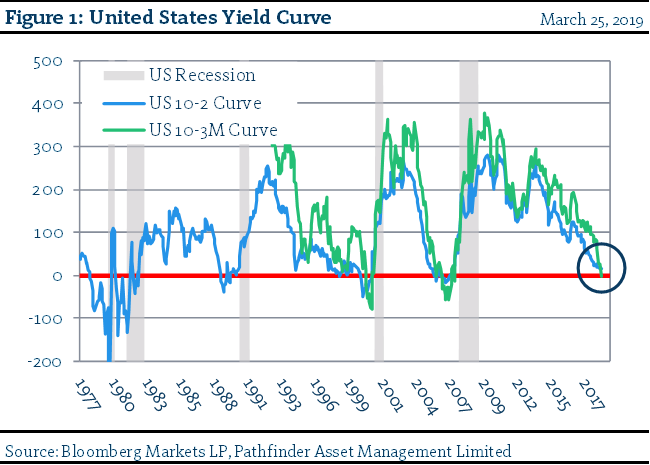Recap & Outlook: European issues remain, inversion
The US and China are the two largest economies in the world. The European Union (EU), as a block, is also a big participant in the global economy (essentially equal to China). The three grouped together account for 65% of global gross domestic product. We wrote about the US and China in the past two Outlook issues so today we write about the EU. In addition, last week the US yield curve inverted. This is a concern for investors and resulted in volatility in North American markets on Friday and overseas into the opening session this week.
- Regular readers of our Outlook will remember that we have been less constructive about Europe for some time. There are some structural issues in Europe that have given us caution for some time. National debt levels and deflation have been well reported on over the years. More recently, Germany, France and Italy have posted flat GDP numbers, 0.6%, 0.9% and 0.3% respectively. This puts the three largest economies (65% of EU) very close to technical recession. With Brexit concerns and other geopolitical issues, we remain concerned. Consequently, we have very little exposure to Europe in our portfolios and expect to remain this way for some time.
- Figure 1 presents US recession and government bond data. Without getting too technical, over time, when the interest paid on short-term bonds is higher than long-term bonds, a recession usually results within 6 months’ time. The blue line is the difference between the yield on 10-year and 2-year bonds, while the green is the difference between 10-year bonds and 3-month bills. The grey bars are US recessions. As you can see, we have approached the zone where, historically, we would be concerned. This past Friday, the green line has turned negative (first time in 12 years) and remains there Monday morning as we write this note. Based on history, this would imply a recession is coming.

“This means that” we will continue to remain underweight in Europe. It would take substantial improvement in the EU economic and political situation over the medium term for us to evolve our investment thesis. We are also following the US bond market data closely and we expect that there could be some financial market volatility from this development. Previously, we had noted that we did not see data that justified recession concern in the US but this is a new development, which we will discuss intensely at our next Investment Committee meeting.
National Instrument 31-103 requires registered firms to disclose information that a reasonable investor would expect to know, including any material conflicts with the firm or its representatives. Doug Johnson and/or Pathfinder Asset Management Limited are an insider of companies periodically mentioned in this report. Please visit www.paml.ca for full disclosures.
*All returns are time weighted and net of investment management fees. Returns from the Pathfinder Partners’ Fund and Partners’ Real Return Plus Fund are presented based on the masters series of each fund. The Pathfinder Core: Equity Portfolio and The Pathfinder Core: High Income Portfolio are live accounts. These are actual accounts owned by the Pathfinder Chairman (Equity) and client (High Income) which contain no legacy positions, cash flows or other Pathfinder investment mandates or products. Monthly inception dates for each fund and portfolio are as follows: Pathfinder North American: Equity Portfolio (January 2011), Pathfinder North American: High Income Portfolio (October 2012) Pathfinder Partners’ Fund (April 2011), Pathfinder Real Return Plus Fund (April, 2013), Pathfinder International Fund (November 2014) and Pathfinder Resource Fund (May 2018).
Pathfinder Asset Management Limited (PAML) and its affiliates may collectively beneficially own in excess of 10% of one or more classes of the issued and outstanding equity securities mentioned in this newsletter. This publication is intended only to convey information. It is not to be construed as an investment guide or as an offer or solicitation of an offer to buy or sell any of the securities mentioned in it. The author has taken all usual and reasonable precautions to determine that the information contained in this publication has been obtained from sources believed to be reliable and that the procedures used to summarize and analyze such information are based on approved practices and principles in the investment industry. However, the market forces underlying investment value are subject to sudden and dramatic changes and data availability varies from one moment to the next. Consequently, neither the author nor PAML can make any warranty as to the accuracy or completeness of information, analysis or views contained in this publication or their usefulness or suitability in any particular circumstance. You should not undertake any investment or portfolio assessment or other transaction on the basis of this publication, but should first consult your portfolio manager, who can assess all relevant particulars of any proposed investment or transaction. PAML and the author accept no liability of any kind whatsoever or any damages or losses incurred by you as a result of reliance upon or use of this publication.